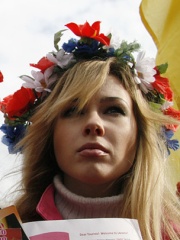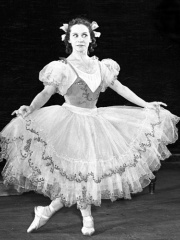







The Most Famous
SOCIAL ACTIVISTS from Ukraine
This page contains a list of the greatest Ukrainian Social Activists. The pantheon dataset contains 840 Social Activists, 19 of which were born in Ukraine. This makes Ukraine the birth place of the 8th most number of Social Activists behind France, and China.
Top 10
The following people are considered by Pantheon to be the top 10 most legendary Ukrainian Social Activists of all time. This list of famous Ukrainian Social Activists is sorted by HPI (Historical Popularity Index), a metric that aggregates information on a biography's online popularity. Visit the rankings page to view the entire list of Ukrainian Social Activists.

1. Simon Wiesenthal (1908 - 2005)
With an HPI of 74.66, Simon Wiesenthal is the most famous Ukrainian Social Activist. His biography has been translated into 57 different languages on wikipedia.
Simon Wiesenthal (31 December 1908 – 20 September 2005) was an Austrian Holocaust survivor, Nazi hunter, and writer. He studied architecture, and was living in Lwów at the outbreak of World War II. He survived the Janowska concentration camp (late 1941 to September 1944), the Kraków-Płaszów concentration camp (September to October 1944), the Gross-Rosen concentration camp, a death march to Chemnitz, Buchenwald, and the Mauthausen concentration camp (February to May 1945). After the war, Wiesenthal dedicated his life to tracking down and gathering information on fugitive Nazi war criminals, so that they could be brought to trial. In 1947, he co-founded the Jewish Historical Documentation Centre in Linz, Austria, where he and others gathered information for future war crime trials and aided Jewish refugees in their search for lost relatives. He opened the Documentation Centre of the Association of Jewish Victims of the Nazi Regime in Vienna in 1961, and continued to try to locate missing Nazi war criminals. He played a small role in locating Adolf Eichmann, who was captured by Mossad in Buenos Aires in 1960, and worked closely with the Austrian justice ministry to prepare a dossier on Franz Stangl, who was sentenced to life imprisonment in 1971. In the 1970s and 1980s, Wiesenthal was involved in two high-profile events involving Austrian politicians. Shortly after Bruno Kreisky was inaugurated as Austrian chancellor in April 1970, Wiesenthal pointed out to the press that four of his new cabinet appointees had been members of the Nazi Party. Kreisky, angry, called Wiesenthal a "Jewish fascist", likened his organisation to the Mafia, and accused him of collaborating with the Nazis. Wiesenthal successfully sued for libel, the suit ending in 1989. In 1986, Wiesenthal was involved in the case of Kurt Waldheim, whose service in the Wehrmacht and probable knowledge of the Holocaust were revealed in the lead-up to the 1986 Austrian presidential elections. Wiesenthal, embarrassed that he had previously cleared Waldheim of any wrongdoing, suffered negative publicity as a result of this event. With a reputation as a storyteller, Wiesenthal was the author of several memoirs containing tales that are only loosely based on actual events. In particular, he exaggerated his role in the capture of Eichmann in 1960. Wiesenthal died in his sleep at age 96 in Vienna in 2005, and was buried in the city of Herzliya in Israel. The Simon Wiesenthal Center, headquartered in Los Angeles, is named in his honour.

2. Fanny Kaplan (1890 - 1918)
With an HPI of 69.41, Fanny Kaplan is the 2nd most famous Ukrainian Social Activist. Her biography has been translated into 41 different languages.
Fanny Efimovna Kaplan (Russian: Фанни Ефимовна Каплан; real name Feiga Haimovna Roytblat, Фейга Хаимовна Ройтблат; 10 February 1890 – 3 September 1918) was a Russian Socialist-Revolutionary who attempted to assassinate Vladimir Lenin. She was arrested and executed by the Cheka in 1918. Born into a Jewish family, Kaplan served a sentence of hard labor during the tsarist years for her revolutionary activities. As a member of the Socialist Revolutionary Party, Kaplan viewed Lenin as a "traitor to the revolution" when the Bolsheviks enacted one-party rule and banned her party. On 30 August 1918, she approached Lenin, who was leaving a Moscow factory, and fired three shots. Lenin was badly injured by two of the shots she fired. Interrogated by the Cheka, she refused to name any accomplices before being executed. The Kaplan attempt and the Moisei Uritsky assassination were used by the government of Soviet Russia for the reinstatement of capital punishment, which had been abolished by the Russian Provisional Government in March 1917.

3. Georgy Gapon (1870 - 1906)
With an HPI of 68.51, Georgy Gapon is the 3rd most famous Ukrainian Social Activist. His biography has been translated into 36 different languages.
Georgy Apollonovich Gapon (17 February [O.S. 5 February] 1870 –10 April [O.S. 28 March] 1906) was a Russian Orthodox priest of Ukrainian descent and a popular working-class leader before the 1905 Russian Revolution. Father Gapon is mainly remembered as the leader of peaceful crowds of protesters on Bloody Sunday, when hundreds of them were killed by firing squads of the Imperial Russian Army.

4. Alexander Pechersky (1909 - 1990)
With an HPI of 66.48, Alexander Pechersky is the 4th most famous Ukrainian Social Activist. His biography has been translated into 25 different languages.
Alexander "Sasha" Aronovich Pechersky (Russian: Алекса́ндр Аро́нович Пече́рский; 22 February 1909 – 19 January 1990), also known as Oleksandr Aronovych Pecherskyi (Ukrainian: Олександр Аронович Печерський), was a Jewish-Soviet officer. He is one of the organizers, and the leader, of the most successful uprising and mass-escape of Jews from a Nazi extermination camp during World War II, which occurred at the Sobibor extermination camp on 14 October 1943. In 1948, Pechersky was arrested by the Soviet authorities along with his brother during the countrywide Rootless cosmopolitan campaign against Jews suspected of pro-Western leanings but released later due in part to mounting international pressure. Pechersky was prevented by the Soviet government from leaving the country to testify in international trials related to Sobibor, including the Eichmann Trial in Israel; foreign investigators were only allowed to collect his testimony under KGB supervision. The last time he was refused permission to exit the country and testify was in 1987, for a trial in Poland.

5. David Riazanov (1870 - 1938)
With an HPI of 63.16, David Riazanov is the 5th most famous Ukrainian Social Activist. His biography has been translated into 23 different languages.
David Riazanov or Ryazanov (Russian: Давид Рязанов), born David Borisovich Goldendakh (Russian: Дави́д Бори́сович Гольдендах; 10 March 1870 – 21 January 1938), was a Russian revolutionary, historian, bibliographer, Marxologist and archivist. He had been an old associate of Leon Trotsky. Riazanov founded the Marx–Engels Institute and edited the first large-scale effort to publish the collected works of these two founders of the modern socialist movement. Riazanov was a prominent victim of the Great Terror of the late 1930s.

6. Haim Arlosoroff (1899 - 1933)
With an HPI of 62.88, Haim Arlosoroff is the 6th most famous Ukrainian Social Activist. His biography has been translated into 15 different languages.
Haim Arlosoroff (23 February 1899 – 16 June 1933; also known as Chaim Arlozorov; Hebrew: חיים ארלוזורוב) was a Socialist Zionist leader of the Yishuv during the British Mandate for Palestine before the establishment of Israel, and head of the Political Department of the Jewish Agency. In 1933, Arlosoroff was assassinated while walking on the beach with his wife in Tel Aviv.

7. Borys Romanchenko (1926 - 2022)
With an HPI of 59.74, Borys Romanchenko is the 7th most famous Ukrainian Social Activist. His biography has been translated into 19 different languages.
Borys Tymofiyovych Romanchenko (Ukrainian: Борис Тимофійович Романченко; 20 January 1926 – 18 March 2022) was a Ukrainian public figure, activist and non-Jewish Holocaust survivor who survived the Buchenwald, Dora and Bergen-Belsen concentration camps. He was killed by Russian airstrikes during the Battle of Kharkiv during the 2022 Russian invasion of Ukraine.

8. Maria Nikiforova (1885 - 1919)
With an HPI of 59.07, Maria Nikiforova is the 8th most famous Ukrainian Social Activist. Her biography has been translated into 18 different languages.
Maria Hryhorivna Nikiforova (Ukrainian: Марія Григорівна Нікіфорова; 1885–1919) was a Ukrainian anarchist partisan leader who led the Black Guards during the Ukrainian War of Independence, becoming widely renowned as an atamansha. A self-described terrorist from the age of 16, she was imprisoned for her activities in Russia before managing to escape to western Europe. With the outbreak of World War I, she took up the defencist line and joined the French Foreign Legion on the Macedonian front before returning to Ukraine with the outbreak of the 1917 Revolution. In her home city of Oleksandrivsk (today Zaporizhzhia), she established an anarchist combat detachment and subsequently attacked the forces of the Russian Provisional Government and the Ukrainian People's Republic. After the October Revolution escalated into a civil war, she joined the side of the Ukrainian Soviet Republic, leading her druzhina in capturing Taurida and Yelysavethrad (today Kropyvnytskyi) from the Ukrainian People's Army. When Ukraine was invaded by the Central Powers, she was forced to flee to Russia, where she was prosecuted for insubordination by the nascent Bolshevik government. When she returned to Ukraine, she briefly participated in the civilian activities of the Makhnovshchina before returning to terrorism. She aimed to assassinate the leaders of the White movement (Anton Denikin and Alexander Kolchak) but was caught and executed.

9. Sergei Kovalev (1930 - 2021)
With an HPI of 58.76, Sergei Kovalev is the 9th most famous Ukrainian Social Activist. His biography has been translated into 23 different languages.
Sergei Adamovich Kovalyov (also spelled Sergey Kovalev; Russian: Сергей Адамович Ковалёв; 2 March 1930 – 9 August 2021) was a Russian human rights activist and politician. During the Soviet period he was a dissident and, after 1975, a political prisoner.

10. Alfreda Markowska (1926 - 2021)
With an HPI of 58.18, Alfreda Markowska is the 10th most famous Ukrainian Social Activist. Her biography has been translated into 19 different languages.
Alfreda Noncia Markowska (10 May 1926 – 30 January 2021) was a Polish-Romani woman who during World War II saved approximately fifty Jewish and Roma children from death in the Holocaust and the Porajmos genocide.
People
Pantheon has 19 people classified as Ukrainian social activists born between 1855 and 1991. Of these 19, 3 (15.79%) of them are still alive today. The most famous living Ukrainian social activists include Oleksandra Matviichuk, Anna Sharyhina, and Alexandra Shevchenko. The most famous deceased Ukrainian social activists include Simon Wiesenthal, Fanny Kaplan, and Georgy Gapon. As of April 2024, 1 new Ukrainian social activists have been added to Pantheon including Kateryna Handziuk.
Living Ukrainian Social Activists
Go to all RankingsOleksandra Matviichuk
1983 - Present
HPI: 52.03
Anna Sharyhina
1978 - Present
HPI: 48.73
Alexandra Shevchenko
1988 - Present
HPI: 44.93
Deceased Ukrainian Social Activists
Go to all RankingsSimon Wiesenthal
1908 - 2005
HPI: 74.66
Fanny Kaplan
1890 - 1918
HPI: 69.41
Georgy Gapon
1870 - 1906
HPI: 68.51
Alexander Pechersky
1909 - 1990
HPI: 66.48
David Riazanov
1870 - 1938
HPI: 63.16
Haim Arlosoroff
1899 - 1933
HPI: 62.88
Borys Romanchenko
1926 - 2022
HPI: 59.74
Maria Nikiforova
1885 - 1919
HPI: 59.07
Sergei Kovalev
1930 - 2021
HPI: 58.76
Alfreda Markowska
1926 - 2021
HPI: 58.18
Leo Deutsch
1855 - 1941
HPI: 57.93
Olga Lepeshinskaya
1916 - 2008
HPI: 57.89
Newly Added Ukrainian Social Activists (2025)
Go to all RankingsOverlapping Lives
Which Social Activists were alive at the same time? This visualization shows the lifespans of the 15 most globally memorable Social Activists since 1700.







